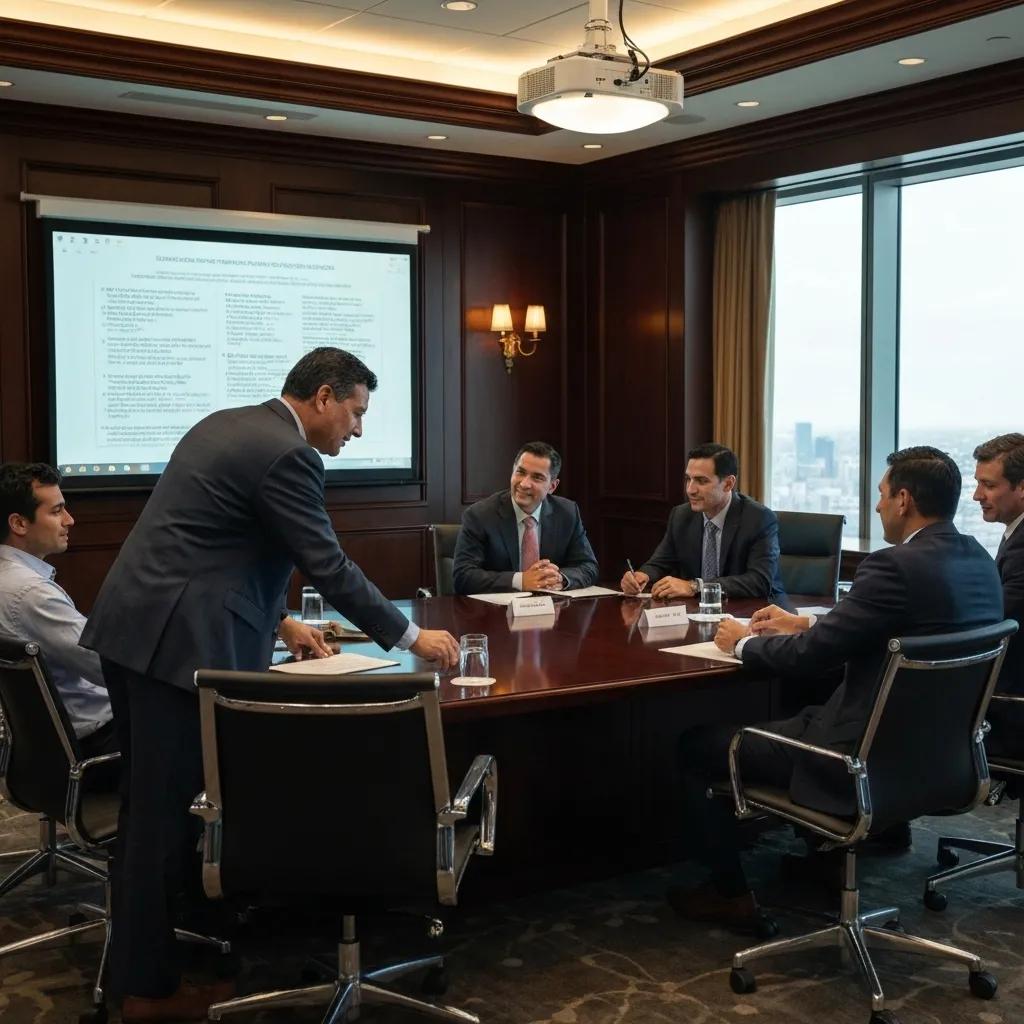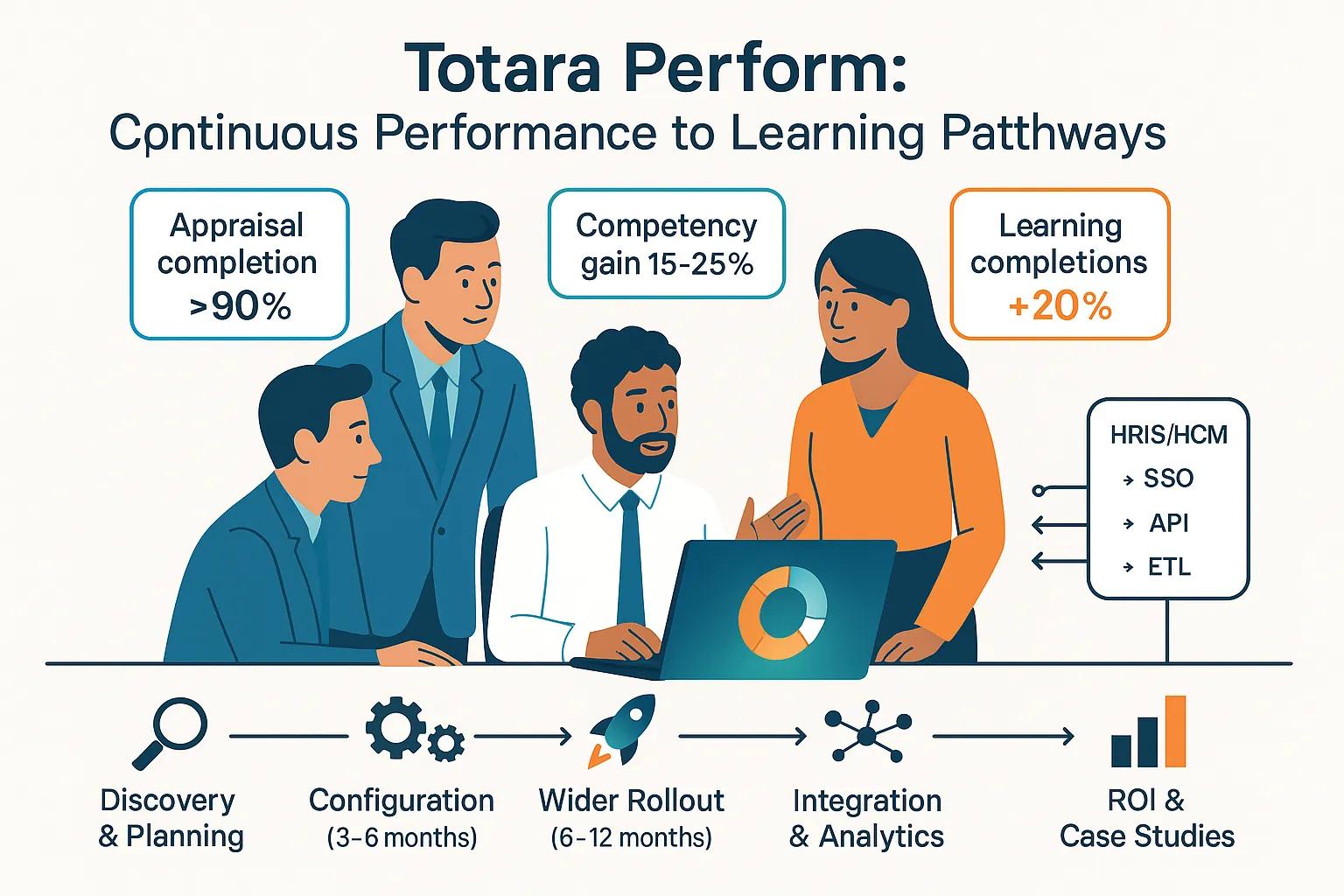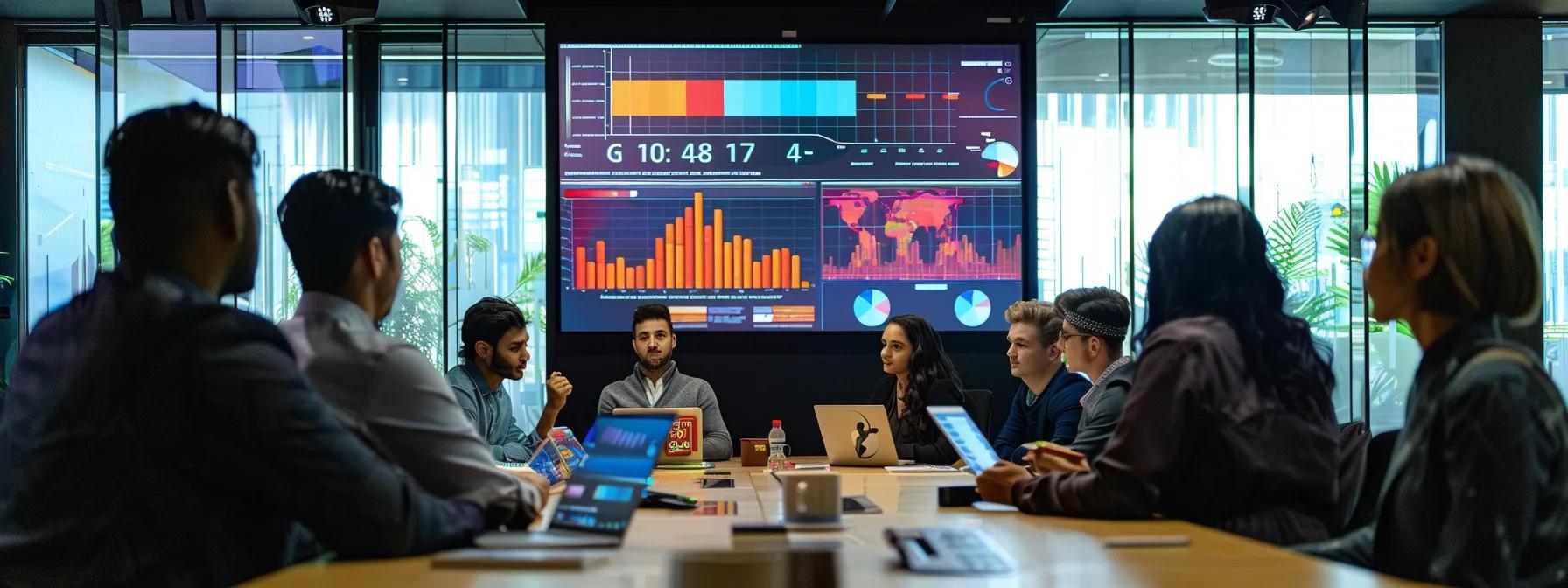
Performance management often stalls because reviews are episodic, competencies are unmanaged, and learning systems are siloed from development workflows. This article explains how Totara Perform addresses those problems by enabling continuous performance management, competency-driven development, and analytics-driven compliance, and shows HR leaders concrete implementation strategies to maximize outcomes. You will learn what Totara Perform is, the core modules HR teams rely on, how it drives engagement through personalized learning pathways, and practical integration patterns with HRIS and HCM systems. For context, this site helps organizations streamline training, meet compliance, and scale learning with Totara and Moodle, offering expert-backed LMS solutions for onboarding, certification, and learner engagement. That stated purpose frames the guidance below, which focuses first on Totara Perform’s capabilities and follows with implementation best practices and measurement approaches for measurable HR impact.
To begin, the guide defines Totara Perform and its role within talent technology stacks and briefly contrasts continuous performance workflows with traditional appraisal cycles. Throughout the article we reference related entities such as Totara Learn and Totara Engage where integration enhances learning-to-performance pathways, and we emphasize practical steps HR managers can take to reduce administrative burden while improving compliance visibility. Readers will find checklists, implementation lists, and three entity-attribute-value tables that map features to outcomes and integration considerations. The guidance is written for HR managers, learning leads, and compliance officers who need both conceptual clarity and actionable next steps for Totara Perform adoption.
What Is Totara Perform and How Does It Enhance HR Performance Management?
Totara Perform is a flexible performance management module designed to support continuous performance cycles, competency frameworks, and goal alignment across an organization. It works by centralizing goal setting, feedback, appraisals, and competency assessments so HR teams can replace episodic reviews with ongoing check-ins and development actions. The direct benefit is improved visibility into employee capabilities and faster skill development because learning assignments and competency gaps flow into personalized learning pathways. Understanding these core mechanics leads naturally into a closer look at the platform’s specific features that HR teams use to operationalize continuous performance and drive measurable results.
Totara Perform integrates with other Totara products and broader HR technology to create an end-to-end talent ecosystem where performance data triggers learning and certification workflows. The platform’s modularity allows teams to enable the goal setting, competency libraries, feedback, and appraisal workflows they need without forcing unnecessary components. This modular approach also supports regulatory workflows because competency and certification status can be tracked and reported centrally. The next subsection lists the core features HR teams commonly deploy and the practical benefits those features deliver.
What Are the Core Features of Totara Perform for HR Teams?
Totara Perform provides a set of interrelated features HR teams use to manage performance, competencies, and reviews in a continuous way. Each feature maps to a practical HR need and accelerates development and compliance tracking when configured correctly. The list below highlights the main modules and a short explanation of their HR impact.
- Goal setting and management: Enables managers and employees to define, cascade, and track objectives linked to organizational KPIs.
- Competency libraries and mapping: Allows HR to catalog required skills, assess proficiency, and map competencies to roles and training.
- Feedback and check-ins: Supports frequent, informal feedback and structured check-ins that replace annual-only conversations.
- Appraisal workflows and 360 reviews: Automates multi-rater reviews, approval routing, and documentation needed for audits.
These features work together to create a continuous feedback loop where competency assessments inform learning assignments and goal progress drives recognition and development.
How Does Totara Perform Support Continuous Performance Management in HR?

Continuous performance management in Totara Perform works by enabling recurrent check-ins, real-time feedback, and dynamic development plans tied to competencies and goals. The mechanism is simple: regular check-ins capture progress and obstacles, feedback entries accumulate qualitative data, and competency assessments highlight skill gaps that trigger targeted learning. The specific benefit is a reduced review lag and faster time-to-skill because managers act on data continuously rather than waiting for annual cycles. Practically speaking, HR teams implement weekly or monthly check-in templates and connect those touchpoints to learning pathways so that identified gaps generate assigned courses or microlearning.
This continuous approach also feeds analytics—managers can see trendlines for goal completion, competency improvement, and feedback frequency, which supports data-driven development decisions. By linking performance events to learning and certification records, organizations create auditable trails for compliance while improving individual development velocity. The next major section explores how these mechanisms increase employee development and engagement.
How Does Totara Perform Improve Employee Development and Engagement?
Totara Perform improves employee development by combining competency-based assessments with automated pathways to targeted learning, creating a personalized growth experience that boosts engagement. The system identifies skill gaps via assessments and maps required competencies to curated learning modules or certifications, enabling employees to see clear development steps. As a result, employees receive relevant learning that connects directly to their performance objectives, which increases motivation and retention by showing a transparent career progression. Understanding competency mapping leads into how competency frameworks actually function as the scaffolding for development and measurable skill improvement.
Personalized learning pathways not only close skill gaps but also reinforce the value exchange between employer investment and employee progression. When learning is aligned to competencies and appraisal outcomes, employees perceive development as purposeful, raising engagement and lowering voluntary turnover risk. The subsection below explains competency management mechanics, while a following list summarizes concrete benefits of targeted learning pathways.
What Role Does Competency Management Play in Employee Skill Development?
Competency management in Totara Perform creates a structured taxonomy of skills and behaviors that HR uses to assess, develop, and certify employees against role expectations. The method involves defining competency frameworks, conducting assessments (self, manager, or third-party), and creating gap analyses that feed development plans. This approach matters because it converts subjective performance ratings into objective skill maps that can be measured and improved through learning. By mapping competencies to specific courses or certifications, organizations ensure that training interventions are purposeful and measurable rather than ad hoc.
Competency-driven workflows also support compliance: when certain competencies are legally required, the system tracks who holds necessary qualifications and issues notifications for recertification. These audit-ready records enable HR to demonstrate compliance during inspections or internal reviews. The next subsection describes how personalized learning pathways are built and why they matter for retention.
How Can Personalized Learning Pathways Boost Talent Retention with Totara Perform?

Personalized learning pathways are automated sequences of learning activities, assessments, and milestones tailored to an employee’s competency gaps and career aspirations, and Totara Perform triggers these pathways from assessment outcomes. The construction typically starts with a competency assessment, which identifies gaps, then assigns courses, microlearning, mentoring, or certification steps to close those gaps. Employees remain engaged because they receive clear, achievable progress markers and role-relevant development that build toward promotion or lateral movement. Over time, visible progression correlates with higher retention because employees perceive ongoing investment in their careers.
Organizations can measure impact by comparing retention and internal mobility rates before and after pathway adoption, and by monitoring completion rates and competency improvements as intermediate indicators. The following section explains how HR managers can streamline formal reviews and appraisals using the platform’s workflow capabilities.
How Can HR Managers Streamline Performance Reviews and Appraisals Using Totara Perform?
Totara Perform streamlines reviews by offering flexible appraisal templates, automated scheduling, and multi-rater workflows that reduce manual administration and improve consistency. The platform automates reminders, route approvals, and collects evidence—such as competency assessments and learning completions—alongside narrative feedback. This automation lowers administrative overhead, increases on-time completion rates, and creates a uniform experience across departments. Once reviews are standardized, HR can shift time from logistics to development coaching, which drives better behavioral outcomes and aligns employee objectives with organizational strategy.
In addition to automation, Totara Perform supports configurable appraisal types—annual, probationary, or project-based—so HR teams can deploy the right workflow for each context and adapt templates as roles change. The system’s 360-degree capabilities let HR combine self-assessments, peer input, and manager evaluations to produce rounded performance views. The next subsection examines the particular benefits of 360 reviews and workflow flexibility.
What Are the Benefits of 360-Degree Feedback and Flexible Workflows?
360-degree feedback combines input from peers, direct reports, and managers to create a fuller view of performance and development needs, and Totara Perform automates collection and aggregation of those responses. This approach reduces single-rater bias and surfaces behavioral patterns that one observer might miss, which improves development planning. Flexible workflows let HR tailor review cycles to role complexity and regulatory requirements, ensuring that high-risk roles receive more frequent, documented assessments. Together, these capabilities enhance fairness, provide richer development data, and support defensive documentation for compliance or talent decisions.
After establishing multi-rater feedback, HR managers often focus on aligning individual goals to business objectives, which is the topic of the following subsection and is central to converting review insights into organizational performance.
How Does Totara Perform Facilitate Strategic Goal Alignment in HR?
Totara Perform facilitates goal alignment through cascading objective features that link individual goals to team and organizational KPIs, enabling visibility and accountability across levels. Managers can create goal hierarchies, assign owners, and track progress in real time so that individual efforts map to strategic outcomes and analytics show aggregated progress. The mechanism ensures that employee activities contribute to measurable business targets and helps HR identify bottlenecks or areas needing investment. With visibility into goal completion and related competency gaps, HR can allocate learning resources where they have the greatest strategic impact.
By tying goals to learning and competencies, Totara Perform creates a closed loop from target-setting through development to outcome measurement, which supports continuous improvement cycles in talent management. The next major section turns to how Totara Perform connects technically to HR systems to make that closed loop operational.
What Are the Integration Capabilities of Totara Perform with Existing HR Systems?
Totara Perform offers multiple integration patterns to synchronize users, goals, competencies, and learning records with HRIS and HCM platforms, enabling a single source of truth for talent data. Common approaches include API-driven data exchange, SSO for unified authentication, and middleware or ETL for bulk provisioning and scheduled syncs. Integration focuses on exchanging user provisioning data, role and reporting hierarchies, competency and goal metadata, and learning completions so that downstream HR processes and payroll or talent modules remain consistent. These integration capabilities minimize duplicate data entry, maintain role-based access, and ensure that performance events are visible to other HR systems.
When planning an integration, teams should define data mappings, frequency of sync, and error-handling procedures while validating privacy and compliance requirements for the data exchanged. The following list summarizes common integration methods and their typical use cases to help HR leaders prioritize integration workstreams.
- Single sign-on (SSO) and identity federation: Provides seamless access and centralized authentication for users across systems.
- API-based synchronization: Exchanges real-time updates for goals, competencies, and learning completions between Totara and HRIS/HCM.
- Middleware or scheduled ETL jobs: Handles bulk user provisioning, hierarchical updates, and nightly data reconciliation.
These integration methods create a robust architecture where performance events in Totara inform HR processes across the enterprise, which leads into specific technical mapping considerations shown in the table below.
| System | Data Exchanged | Integration Consideration |
|---|---|---|
| HRIS / HCM | User profiles, employment status, reporting lines | Use SSO and API provisioning to keep identities and hierarchies synchronized |
| Identity Provider | Credentials, single sign-on tokens | Implement SSO with secure federated authentication (SAML/OIDC) |
| Talent Tools (recruiting, succession) | Competency requirements, job profiles, goal templates | Map competency IDs and version control to avoid misalignment |
How Does Totara Perform Seamlessly Integrate with HRIS and Talent Management Tools?
Seamless integration is achieved by aligning data models, leveraging APIs for transactional events, and using SSO for user experience continuity so that employees and managers access one coherent environment. The process typically starts with a discovery phase to map entities—users, roles, competencies, goals—and then designs the synchronization cadence and conflict resolution rules. When goal and competency data are synchronized, learning completions in Totara automatically update employee records in the HRIS, supporting talent decisions and compliance reporting. Clear integration patterns reduce duplication, accelerate adoption, and make performance data actionable across HR processes.
Implementers should also plan for versioning of competency frameworks and establish governance to avoid divergent taxonomy across systems. Ensuring consistent identifiers and metadata schemas across Totara and enterprise systems is fundamental to long-term data integrity. The next subsection outlines reporting features that make integrated data useful for compliance and decision-making.
What Reporting and Analytics Features Support HR Compliance and Decision-Making?
Totara Perform includes standard and custom reporting, dashboards, and exportable audit trails that support compliance checks and strategic HR analysis. Reports commonly include certification expiry lists, appraisal completion rates, competency improvement trends, and goal completion summaries, all of which feed compliance and risk reviews. Audit trails capture who changed competencies, who completed reviews, and learning completion timestamps, enabling HR to demonstrate regulatory adherence or internal policy compliance. Analytics dashboards allow managers to slice data by team, location, role, or competency, which supports targeted interventions and resource allocation.
Custom report builders let HR create bespoke outputs to meet internal or external audit requirements, and scheduled exports can automate reporting to governance teams. With integration to HRIS, these reports populate centralized talent KPIs, allowing leadership to connect development investments to workforce capability improvements. The following section explains why a certified Totara partner can help accelerate these implementations.
Why Choose Markanyx Solutions for Totara Perform Implementation and Support?
Markanyx Solutions Inc. is a certified Totara Partner with implementation experience and services tailored to Totara Perform deployments, and the company focuses on practical outcomes such as onboarding, certification, and learner engagement. Their service offering emphasizes custom development to adapt Totara Perform to organizational taxonomies, managed hosting to ensure platform reliability, and dedicated multilingual and 24/7 support to serve diverse user bases. Markanyx positions Canadian data hosting as an advantage for organizations requiring Canadian residency of learner data and supports scalable learning solutions across Totara and Moodle platforms. Choosing a certified partner helps HR teams reduce rollout risk and align the platform to compliance and scalability requirements.
Working with an experienced implementer also helps translate performance workflows into technical configurations, such as scripting automated appraisal workflows, building competency libraries, and designing audit-ready reports. The following H3s outline typical services and support approaches offered by Markanyx that align with Totara Perform implementations.
What Expert Services Does Markanyx Offer for Customizing Totara Perform?
Markanyx offers custom development and configuration services that adapt Totara Perform to organizational competency frameworks, appraisal templates, and goal hierarchies so HR processes map directly to the platform. Their engagements typically include discovery workshops, configuration of modules (goals, competencies, feedback), custom plugin or report development when standard functionality needs extension, and integration work with HRIS/HCM systems. Additionally, they provide hosting and managed services for platform stability and multilingual capabilities to support diverse learner populations. These services help organizations achieve smoother deployments and faster realization of performance management benefits.
By leveraging a partner for technical tasks, HR teams can focus on change management and adoption, while the partner handles technical risk and scalability planning. The next subsection describes how ongoing support is structured to sustain HR success.
How Does Markanyx Ensure Ongoing Support and Scalability for HR Success?
Markanyx ensures ongoing support and scalability through managed hosting, monitoring, and continuous support channels—highlighting multilingual and 24/7 availability to address operational issues across time zones. Their managed hosting approach supports scaling user loads, regular updates to keep Totara secure and current, and monitoring to detect performance or integration issues early. The multilingual support capability helps global workforces access localized interfaces and documentation, improving adoption and reducing friction. Ongoing customization and training services ensure that HR teams can evolve appraisal templates, competency frameworks, and reporting as organizational needs change.
This combination of technical services and continuous support enables HR leaders to treat Totara Perform as a strategic platform rather than a one-time project, which prepares organizations to measure impact and iterate on their performance programs.
How Can Organizations Measure the ROI and Success of Totara Perform in HR?
Measuring ROI for Totara Perform requires mapping platform capabilities to HR KPIs and establishing baselines before deployment so that changes can be attributed to the system. Common metrics include appraisal completion rates, competency proficiency improvements, goal completion rates, learning completion and certification rates, engagement and active-user metrics, and retention or internal mobility trends. Totara’s reporting and analytics capabilities capture many of these data points directly, enabling HR to calculate delta changes over quarterly or annual cycles. Defining clear measurement windows and control cohorts strengthens causal claims about impact.
A metrics-focused EAV table below helps HR translate KPIs into measurable Totara outputs and suggested benchmarks for evaluation.
| Metric | How Totara Measures It | Target / Benchmark |
|---|---|---|
| Appraisal completion rate | Workflow completion logs and timestamps | >90% on-time completion |
| Competency proficiency | Assessment scores pre/post and mean change | 15-25% average proficiency gain |
| Goal completion rate | Goal status and progress tracking | 75%+ completion for critical KPIs |
| Learning completion | Course completion and certification records | Increase of 20% in targeted learning completions |
What Key Metrics Demonstrate Improved Employee Engagement and Productivity?
Key metrics that demonstrate engagement and productivity improvements include active user rates, frequency of feedback/check-ins, completion rates for assigned learning pathways, changes in competency assessment scores, and correlations between goal attainment and business outcomes. Measuring these involves baseline data collection followed by periodic measurement windows—monthly for usage metrics and quarterly for competency and productivity outcomes. HR should complement platform data with pulse surveys or qualitative inputs to capture perceived development and manager coaching quality. A mixed-methods approach provides robust evidence of Totara Perform’s effects on employee experience and performance.
Using these metrics, organizations can build ROI models that quantify time saved in administration, reductions in external training costs due to internal pathways, and retention value from improved engagement. The next subsection considers how case studies illustrate typical improvements.
How Do Case Studies Illustrate the Benefits of Totara Perform for HR Teams?
Case studies typically show measurable improvements such as higher appraisal completion rates, faster competency closing times, and improved compliance reporting after Totara Perform deployment, and these examples help HR build the business case for investment. Successful implementations often combine technical integration, targeted competency frameworks, and change management focused on manager training and adoption. Typical timelines show initial configuration and pilot in 3–6 months, wider rollout over the next 6–12 months, and measurable KPI improvements within the first year. Lessons learned commonly highlight the importance of governance for competency taxonomies and iterative reporting refinement.
These practical examples demonstrate that Totara Perform delivers value when paired with disciplined measurement and an implementation partner that can align the platform with HR processes. Organizations ready to translate these insights into action should prepare baseline metrics and consider a partner-assisted pilot to accelerate outcomes.
Frequently Asked Questions
1. What types of organizations can benefit from using Totara Perform?
Totara Perform is designed to support a wide range of organizations, from small businesses to large enterprises, across various industries. Any organization that seeks to enhance its performance management processes, improve employee engagement, and streamline compliance can benefit from this platform. It is particularly useful for HR teams looking to implement continuous performance management, competency frameworks, and personalized learning pathways. Organizations focused on talent development and regulatory compliance will find Totara Perform especially advantageous.
2. How does Totara Perform ensure data security and compliance?
Totara Perform prioritizes data security and compliance through robust measures such as data encryption, secure user authentication, and regular security audits. The platform is designed to comply with various data protection regulations, including GDPR, ensuring that personal data is handled responsibly. Additionally, organizations can customize access controls to ensure that sensitive information is only available to authorized personnel. This focus on security helps organizations maintain compliance while leveraging the platform for performance management.
3. Can Totara Perform be integrated with other learning management systems?
Yes, Totara Perform can be integrated with various learning management systems (LMS) to create a cohesive learning and performance ecosystem. The platform supports API-driven integrations, allowing seamless data exchange between Totara Perform and other LMS platforms. This integration enables organizations to synchronize learning records, competencies, and performance data, ensuring that all systems work together efficiently. By connecting different systems, organizations can enhance their training and development initiatives while maintaining a single source of truth for talent data.
4. What kind of training is available for HR teams using Totara Perform?
Training for HR teams using Totara Perform typically includes comprehensive onboarding sessions, workshops, and ongoing support tailored to the organization’s needs. Markanyx Solutions, as a certified Totara partner, offers customized training programs that cover platform features, best practices for implementation, and strategies for maximizing the system’s capabilities. This training ensures that HR teams are well-equipped to utilize Totara Perform effectively, fostering a culture of continuous improvement and performance management within the organization.
5. How can organizations track the effectiveness of Totara Perform?
Organizations can track the effectiveness of Totara Perform through various metrics and reporting features available within the platform. Key performance indicators (KPIs) such as appraisal completion rates, competency improvements, and goal attainment can be monitored using built-in analytics and custom reports. Regular assessments and feedback loops also provide insights into employee engagement and development progress. By establishing baseline metrics before implementation, organizations can measure changes over time and evaluate the impact of Totara Perform on their HR processes.
6. What support options are available for organizations after implementing Totara Perform?
After implementing Totara Perform, organizations can access a range of support options, including ongoing technical assistance, managed hosting services, and continuous training. Markanyx Solutions provides 24/7 multilingual support to address operational issues and ensure platform stability. Additionally, organizations can receive help with customizing features, updating competency frameworks, and refining reporting processes as their needs evolve. This ongoing support helps organizations maximize their investment in Totara Perform and adapt to changing HR requirements.
7. How does Totara Perform enhance employee feedback mechanisms?
Totara Perform enhances employee feedback mechanisms by facilitating regular check-ins and real-time feedback opportunities. The platform allows for informal feedback and structured reviews, moving away from traditional annual performance appraisals. This continuous feedback loop encourages open communication between employees and managers, fostering a culture of transparency and growth. By integrating feedback into performance management processes, organizations can identify development needs more effectively and support employees in their career progression.





